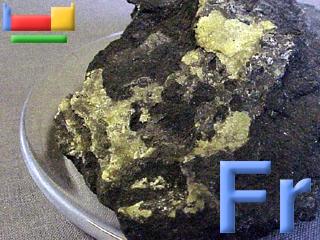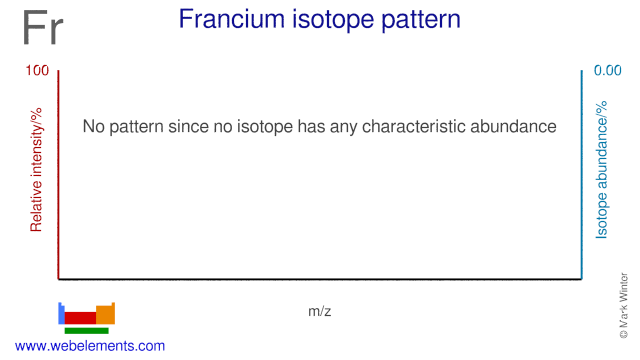Francium - 87Fr: the essentials
- Name: francium
- Symbol: Fr
- Atomic number: 87
- Relative atomic mass (Ar): [ 223 ] (longest lived isotope)
- Standard state: solid at 298 K
- Appearance: metallic
- Classification: Metallic
- Group in periodic table: 1
- Group name: Alkali metal
- Period in periodic table: 7
- Block in periodic table: s
- Shell structure: 2.8.18.32.18.8.1
- CAS Registry: 7440-73-5
Francium atoms have 87 electrons and the shell structure is 2.8.18.32.18.8.1. The ground state electronic configuration of neutral francium is [Rn].7s1 and the term symbol of francium is 2S1/2.
Francium: description
Francium occurs as a result of α disintegration of actinium. Francium is found in uranium minerals, and can be made artificially by bombarding thorium with protons. It is the most unstable of the first 101 elements. The longest lived isotope, 223Fr, a daughter of 227Ac, has a half-life of 22 minutes. This is the only isotope of francium occurring in nature, but at most there is only 20-30 g of the element present in the earth's crust at any one time. No weighable quantity of the element has been prepared or isolated. There are about 20 known isotopes.

This sample of uraninite contains some francium because of a steady-state decay chain. An estimate suggests there is about 10-20 grammes of francium (about 1 atom!) at any one time. Image adapted with permission from Prof James Marshall's (U. North Texas, USA) Walking Tour of the elements CD.
Francium: physical properties
Density of solid: 2900 (estimated) kg m-3
Molar volume: 77 (rough estimate based upon density estimate) cm3
Thermal conductivity: 15 (estimate) W m‑1 K‑1
Francium: heat properties
Melting point: maybe about 300 [about 30 °C, estimate] K
Boiling point: 871 [598 °C (1108 °F)] K
Enthalpy of fusion: 20.5 kJ mol-1
Francium: atom sizes
Atomic radius (empirical): (no data) pm
Molecular single bond covalent radius: 223 (coordination number 1) ppm
van der Waals radius: 282 ppm
Francium: electronegativities
Pauling electronegativity: 0.7 (Pauling units)
Allred Rochow electronegativity: 0.86 (Pauling units)
Mulliken-Jaffe electronegativity: 0.68 (s orbital)
Francium: orbital properties
First ionisation energy: 392.96 kJ mol‑1
Second ionisation energy: 2160 kJ mol‑1
Third ionisation energy: 3230 kJ mol‑1
Francium: abundances
Universe: (no data) ppb by weight
Crustal rocks: (no data) ppb by weight
Human: (no data) ppb by weight
Francium: crystal structure

Francium: biological data
Human abundance by weight: (no data) ppb by weight
Francium has no biological role.
Francium: uses
Francium: reactions
Reactions of francium as the element with air, water, halogens, acids, and bases where known.
Francium: binary compounds
Binary compounds with halogens (known as halides), oxygen (known as oxides), hydrogen (known as hydrides), and other compounds of francium where known.
Francium: compound properties
Bond strengths; lattice energies of francium halides, hydrides, oxides (where known); and reduction potentials where known.
Francium: history
Francium was discovered by Marguerite Perey in 1939 at France. Origin of name: named after "France".Francium: isotopes

Francium: isolation
Isolation: francium is vanishingly rare and is found only as very small traces in some uranium minerals. It has never been isolated as the pure element. As it is so radioactive, any amount formed would decompose to other elements.
Actinium decays by β decay most of the time but about 1% of the decay is by α decay. The "daughter" element of this reaction, which used to be called actinium-K, is now recognized as 22387Fr - the longest-lived isotope of actinium with a half life of about 22 minutes.
